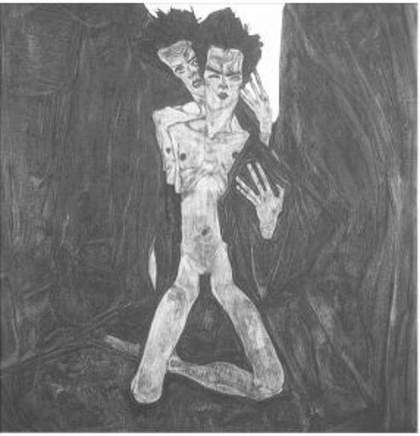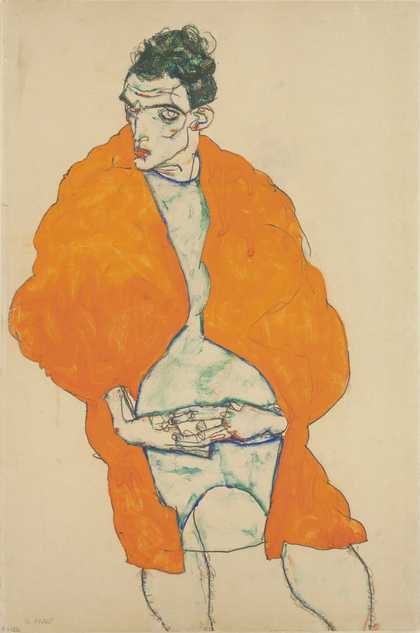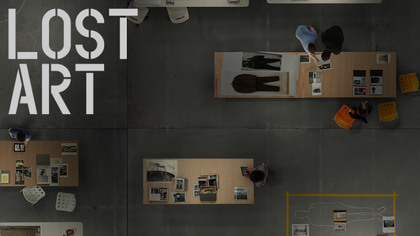
Egon Schiele
Self-Seer 1910
Oil paint on canvas
80 x 79.9 cm
Egon Schiele’s Self-Seer 1910 was the first in a series of three double self-portraits, and although missing for over seventy years and known only through a poor black and white photograph, the lost canvas remains much discussed by those interested in the work of the famous Austrian artist.
Schiele’s early career was defined by his relationship with Gustav Klimt, the most famous painter associated with the Austrian Secession movement. In 1907 Schiele contacted Klimt, who proceeded to introduce the talented teenager to artists and collectors in Vienna. In early 1910, Schiele, then only twenty, moved away from the decorative style of his mentor and began to emphasise the grotesque in his self-portraits, showing his face distorted, his skin discoloured and his body brutally truncated. Viewing sexuality with a rare directness that, to some, bordered on the pathological, Schiele also found himself in trouble with the authorities on a number of occasions for his sexually explicit drawings and paintings.
In Self-Seer, completed in December 1910, a strangely de-sexed, naked Schiele is shown kneeling and partly enveloped in a dark garment. Behind him, mimicking his rigid hand gesture, is a youthful twin figure. It was one of a series of three double self-portraits. For art historian Alessandra Comini the series became ‘in part a battle before the mirror, between the artist as creator of and vessel for his own image’.
Schiele died in 1918, aged just twenty-eight, a victim of a Spanish flu epidemic that claimed more than twenty million lives across Europe. Nonetheless, his fame continued to grow after his death and in the 1920s Fritz Grünbaum, a successful cabaret artist who built up a significant collection of modern art, acquired Self-Seer.
In March 1938 Austria was annexed to the German Reich. The new National Socialist authorities immediately began the process of excluding Austria’s Jewish community, and other opponents of their regime, from society. Attempting to flee to Czechoslovakia by train, Fritz Grünbaum and his wife Lily were arrested and returned to Vienna. Grünbaum was deported to the Dachau concentration camp in May 1938, while in Vienna Lily was left to ‘authorise’ the governmental confiscation of the couple’s property. A property assessment for Lily Grünbaum dated 20 July 1938 provides the last record of Self-Seer. Following the confiscation of her apartment in October 1938 Lily Grünbaum was registered at four different addresses between 1938 and 1942. She was finally arrested in 5 October 1942 and deported to the Maly Trostinc extermination camp nearMinsk, where she was murdered on 9 October. Her husband had already died.
The story of Self-Seer does not end there. After Lily Grünbaum’s deportation, her collection would have become the property of the German Reich. In theory, the collection should have been confiscated and sold off through a sub-section of the Gestapo responsible for selling off Jewish-owned luxury goods. But the Grünbaum collection does not figure in any of the related records. In 1956, however, around forty Schiele works from the Grünbaum collection appeared on the market via a dealership in Switzerland. According to the dealership’s owner, he had acquired the work from the sister of Lily Grünbaum, who survived the war. The sale included works by Schiele that had appeared alongside Self-Seer in Lily Grünbaum’s 1938 property assessment, and the hope remains that the missing work may yet resurface one day.



